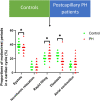Cine magnetic resonance imaging detects shorter cardiac rest periods in postcapillary pulmonary hypertension
- PMID: 35718877
- PMCID: PMC10226745
- DOI: 10.1093/ehjci/jeac113
Cine magnetic resonance imaging detects shorter cardiac rest periods in postcapillary pulmonary hypertension
Abstract
Aims: A shorter cardiac rest period within a cardiac cycle is usually thought to be a result of a fast heart rate, and its clinical relevance has long been ignored. The aim of the present study was to test the hypothesis that the length of cardiac rest periods is altered in postcapillary pulmonary hypertension (PH).
Methods and results: Twenty-six patients with postcapillary PH and 20 healthy controls were recruited for cardiac magnetic resonance imaging (MRI) scans. All participants had a heart rate no higher than 80 beats/minute. Cine magnetic resonance imaging (MRI, acquired at a four-chamber view) was analyzed to determine the length of cardiac rest periods at end-systole and mid-to-late diastole. PH patients had a shorter rest period at mid-to-late diastole than controls (17.5 ± 8.7% vs. 24.2 ± 4.2%, P = 0.003). Receiver operating characteristic (ROC) curves showed that the proportion of the rest period in diastole (defined as the length of diastasis/diastole) can discriminate PH patients from controls [area under the curve (AUC) = 0.83, 95% confidence interval (CI): 0.71-0.96]. The existence of postcapillary PH was a significant contributor (β = -5.537, P = 0.023) to shorter cardiac rest periods at mid-to-late diastole after adjusting for potential confounders, including age, sex, heart rate, and blood pressure.
Conclusions: Postcapillary PH is independently associated with shorter cardiac rest periods at mid-to-late diastole. The length of cardiac rest periods has the potential to become a novel quantitative imaging biomarker for indicating cardiovascular health.
Keywords: cardiac rest periods; cine magnetic resonance imaging; postcapillary pulmonary hypertension.
© The Author(s) 2022. Published by Oxford University Press on behalf of the European Society of Cardiology. All rights reserved. For permissions, please email: journals.permissions@oup.com.
Conflict of interest statement
Conflict of interest: This study was supported by Bayer Pharmaceutical. The grant was paid to the institution not to individual investigators. James C. Carr has disclosures: Siemens: research grant to institution; advisory board Bayer: research grant to institution; advisory board; speaker Bracco: advisory board Guerbet: research grant to institution No other authors have conflict of interest.
Figures




Similar articles
-
Cine MRI detects elevated left heart pressure in pulmonary hypertension.J Magn Reson Imaging. 2021 Jul;54(1):275-283. doi: 10.1002/jmri.27504. Epub 2021 Jan 9. J Magn Reson Imaging. 2021. PMID: 33421234
-
Relationship between heart rate and quiescent interval of the cardiac cycle in children using MRI.Pediatr Radiol. 2017 Nov;47(12):1588-1593. doi: 10.1007/s00247-017-3918-6. Epub 2017 Jul 25. Pediatr Radiol. 2017. PMID: 28744611
-
Functional magnetic resonance imaging for in vivo quantification of pulmonary hypertension in the Sugen 5416/hypoxia mouse.Exp Physiol. 2017 Mar 1;102(3):347-353. doi: 10.1113/EP086067. Epub 2017 Feb 14. Exp Physiol. 2017. PMID: 27897352
-
Imaging in the evaluation of pulmonary artery hemodynamics and right ventricular structure and function.Heart Fail Clin. 2012 Jul;8(3):353-72. doi: 10.1016/j.hfc.2012.04.004. Epub 2012 May 17. Heart Fail Clin. 2012. PMID: 22748899 Review.
-
Cardiac magnetic resonance imaging and its electrocardiographs (ECG): tips and tricks.Int J Cardiovasc Imaging. 2012 Aug;28(6):1465-75. doi: 10.1007/s10554-011-9957-4. Epub 2011 Oct 28. Int J Cardiovasc Imaging. 2012. PMID: 22033762 Free PMC article. Review.
Cited by
-
Radiomics features of the cardiac blood pool to indicate hemodynamic changes in pulmonary hypertension (PH) due to heart failure with preserved ejection fraction (PH-HFpEF).Int J Cardiovasc Imaging. 2024 Jul;40(7):1501-1509. doi: 10.1007/s10554-024-03131-w. Epub 2024 May 27. Int J Cardiovasc Imaging. 2024. PMID: 38801547
References
-
- Lu B, Mao SS, Zhuang N, Bakhsheshi H, Yamamoto H, Takasu J, et al. . Coronary artery motion during the cardiac cycle and optimal ECG triggering for coronary artery imaging. Invest Radiol 2001;36:250–6. - PubMed
-
- Wang Y, Vidan E, Bergman GW. Cardiac motion of coronary arteries: variability in the rest period and implications for coronary MR angiography. Radiology 1999;213:751–8. - PubMed
MeSH terms
Grants and funding
LinkOut - more resources
Full Text Sources
Medical

